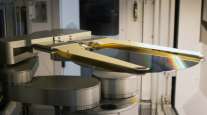China’s Wider Fight With US Is Only Just Beginning After Trade Deal

[Stay on top of transportation news: Get TTNews in your inbox.]
In a letter read out during the Jan. 15 trade deal signing at the White House, Chinese leader Xi Jinping asked U.S. President Donald Trump to take steps to “enhance mutual trust and cooperation between us.”
That won’t be easy: Apart from the trade agreement, the U.S. and China are butting heads on everything from technology to human rights to territorial disputes. Just this week, Secretary of State Michael Pompeo told executives in Silicon Valley the U.S. is “facing a challenge from China that demands every fiber of your innovative skill and your innovative spirit.”
A return to acrimony could have major consequences for China, and for Xi. In the short term, renewed tensions with the U.S. risk weakening an already fragile economic situation, while investment restrictions could hamper plans to secure technologies essential to driving growth. For Xi, a perceived failure to manage U.S. ties could also dent support for a third term in office at a key Communist Party meeting in 2022.
“This is China’s most important bilateral relationship by a country mile, and Xi Jinping has made it clear that he’s in charge from the beginning,” said Trey McArver, co-founder of Beijing-based research firm Trivium China. “He’s under pressure to do a good job because if he doesn’t it opens him up to criticism that he’s not a good statesman and not a good steward of the nation.”
RELATED: US, China Sign Deal That Aims to Simmer Long-Running Trade Tensions
Early on, Xi defined the terms of a successful relationship. Even before taking the top job in 2012, he called for a “new type of great power relations” that would see the two powers respect each other’s “core interests” and abandon a “zero-sum” mentality.
Just days before Trump took office in 2017 after campaigning on an “America First” platform, Xi sought to claim the mantle as a defender of free trade by preaching “openness” and “economic liberalization” at the World Economic Forum in Switzerland. Later that year, he declared that China was “approaching the center of the world stage” as he outlined a road map for turning the country into a leading global power by 2050.
‘They’re Way Behind’
Trump, however, sought to thwart those plans. His move to raise tariffs has disrupted China’s export-led economic model, accelerating a shift in global supply chains as lower-cost manufacturers look for cheaper places to set up shop. It also opened the door for his administration to blacklist Huawei Technologies Co. and other burgeoning Chinese tech companies that still rely on U.S. firms for vital components.
“If you go back five, six, seven years, in 2019 they say China was going to catch us as the world’s largest economy,” Trump told supporters at a rally last month. “Guess what? They’re way behind. They’re way behind.”
For Xi, the phase-one deal helps stop the bleeding on the trade war. And while he has struck an optimistic tone along with other Chinese officials, the text of the deal itself speaks to the wide gap between the world’s biggest economies. Its limited scope, highlighted by whopping agricultural and energy purchases, defers tougher issues like Beijing’s controversial state subsidies, industrial policies and state-owned enterprises.
Compromise on state-owned enterprises will prove difficult because they are an “organic component of China’s political and economic governance,” said Wang Peng, associate research fellow at Renmin University’s Chongyang Institute for Financial Studies.
In other words, they are a crucial lever for keeping Xi and the Communist Party in power. Opening certain parts of the economy to foreign competition could spark instability as the government seeks to maintain economic growth and employment. And more than leaders before him, Xi has sought total control over any potential threats to power, from corrupt officials to ethnic Uighurs to even a free-market think tank.
‘Orwellian Surveillance State’
In San Francisco this week, Pompeo urged technology companies to “confront tough questions about the national security consequences of doing business in a country controlled by the Chinese Communist Party.”

Pompeo
“We need to make sure that our companies don’t do deals that strengthen a competitor’s military or tighten the regime’s grip of repression in parts of that country,” Pompeo said. “We need to make sure American technology doesn’t power a truly Orwellian surveillance state.”
Even with the trade deal, Trump is moving to further curtail Huawei’s ability to operate as it continues a campaign to dissuade other countries from using its 5G technology. This week, Reuters reported that the Commerce Department has drafted a rule that would allow it to block U.S. exports to Huawei if U.S. components make up more than 10% of product value.
Lawmakers from both parties are also taking action. Congress voted overwhelmingly last month to pressure China over Hong Kong, and they are pushing for measures to punish Beijing for its detention of an estimated 1 million ethnic Uighur Muslims in “re-education” camps.
Then there are military tensions. Since the Pentagon officially labeled China a “strategic competitor” in 2018, the Trump administration has challenged China on multiple fronts. It increased patrols in the South China Sea and approved an $8 billion sale of F-16 fighter jets to Taiwan, the first such deal in almost 30 years. Just last week, the U.S. Army announced it would deploy a specialized task force to the Pacific capable of conducting information, electronic, cyber and missile operations against Beijing.
On Jan. 16, the U.S. sailed a warship through the Taiwan Strait. The U.S. Navy conducted nine transits through the waterway last year, the most since former President Barack Obama’s final year in office in 2016.
Long March
Xi’s goal now is to shore up political support at home while also softening China’s image abroad. A Pew Research Center Survey poll last month found that China’s favorability ratings fell dramatically last year in countries from Canada and Australia to Indonesia and the Philippines.
China has sought to allay fears that Xi’s Belt and Road infrastructure initiative would saddle poorer countries with debt. He’s also prioritizing “neighborhood diplomacy” to assert leadership in Asia, mending ties with Japan and South Korea while also reaching out to places like Vietnam where tensions have risen. He’ll take his first foreign trip this year on Jan. 17 to Myanmar.
At home, Xi is also taking steps to bolster China’s ability to modernize without the U.S. if necessary. After the last round of talks broke down in May last year, Xi renewed long-standing calls for “self-reliance” in key technologies and even called for a “new Long March.”
It also appears that concerns in the party over his push for a more assertive foreign policy, which marks a departure from former leader Deng Xiaoping’s call for “hiding brightness and biding time,” haven’t affected his official ascent. The Communist Party’s elite Politburo last month dubbed Xi the “people’s leader” — a term once used to describe Mao Zedong — after previously agreeing to remove presidential term limits and enshrine his name in the constitution.
Either way, while businesses are relieved at the temporary easing of tensions, few are under any illusions that deeper tensions will abate.
“This trade deal is a good thing if it can reduce tension,” said James McGregor, China chairman of APCO Worldwide, which advises foreign companies. “But only time will tell if it puts us on a path to finding a way for two incompatible development models to coexist and work together. That is something way beyond the parameters of any trade deal.”
Want more news? Listen to today's daily briefing:




